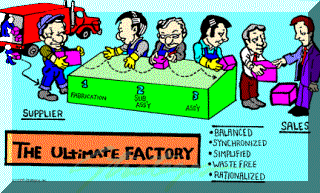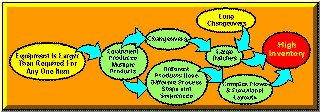Towards A Lean Manufacturing Strategy
The Mental Model

Carl von Clausewitz
Thus, then, in Strategy everything is very simple, but not on that account very easy.
A Mental Model
Taiichi Ohno and Shigeo Shingo developed and implemented Lean Manufacturing at Toyota over a period of 20-30 years. Their approach provides a mental model for other implementations.
Ohno first visualized an ideal production system, in terms of workflow. Ohno's ideal system was inspired Eiji Toyoda's observations at Ford Motor Company. The ideal production system was a series of adjacent workstations that were balanced and synchronized with no inventory between stations. It delivered finished product to the customer exactly when needed (Just In Time) and drew materials, Just In Time. According to legend, Ohno (or, possibly, Eiiji toyoda) asked what prevented the realization of this ultimate, no-inventory system. As the reasons surfaced, Ohno requested his deputies to "eliminate the reasons." The resulting elements of Lean Manufacturing aim at eliminating (or at least reducing) the reasons for inventory. While the real goal is to eliminate waste, Ohno understood that inventory mirrors waste.
This is an example of what Edward DeBono calls "Lateral Thinking." By imagining an ideal, but seemingly impossible situation, we can often see more clearly, the path to its realization. Ohno and Shingo did not intend to develop some sort of "Unified Field Theory" for all manufacturing. They simply wanted to solve Toyota's specific problems. The solutions they chose, while broad based, do not necessarily apply in all situations. Your solutions may be different.

Ohno's Mental Model
Visualizing the ultimate factory through a Mental Model helps to identify constraints and focus strategy.
Using The Mental Model
First, imagine the ultimate factory as shown above with your products and customers. Then ask the following questions:
What would be the characteristics of the equipment, people and layout in this factory?
What must be true for this to be possible?
What are the root causes for inventory in our plant?
An Example

In many factories a primary "reason for inventory" involves intertwined issues of equipment scale, setup, batching, and workflow. The causal diagram (below) illustrates. The problem starts with equipment that is larger and faster than required for a single product. This causes multiple products to run on the same equipment. Two effects ensue:
1) Changeovers become necessary.
2) Different products follow different routes.
In addition, large-scale equipment often requires difficult and time-consuming setups. The combination of changeover and long setup forces large batches that promote high inventory. Different routes force functional layouts with complex flows that also increase inventory.
High inventory brings all sorts of waste in material handling, space and quality (not shown). This diagram is over-simplified. In reality, it has multiple, subtle reinforcing loops that exacerbate the problem over time.
At Toyota, Shingo attacked both root causes. First, he developed the SMED system that reduced changeover times and, thus, batch sizes and inventory. Second, he scaled down the equipment, where possible, thus enabling Cellular Manufacturing and its simplified workflow.
SMED and workcells did not become part of the Toyota Production System because they had some sort of cosmic virtue. They were employed because they reduced inventory and waste in the Toyota context.
The Key Point
Systems Thinking visualizes causes and effects, interactions and dynamic behaviors. Both Systems Thinking and Lateral Thinking are important when developing a Lean Manufacturing Strategy for your particular plant. This is where leadership plays a key role.

Causal Diagram for Setup Reduction (SMED)
The arrows in this diagram indicate influences. This particular diagram shows that one cause of high inventory is the selection of large equipment that must run many products.
Our Mental Model is simple; the implications profound. It led Toyota to setup reduction, workcells and, eventually, the other tools of Lean Manufacturing. In other situations, it may lead to a somewhat different set of tools.
The moral:
- Do not copy blindly Toyota's specific tools and techniques blindly; they are not universal.
- Use Toyota's Mental Model, it is universal.
■ ■ ■ ■ ■ ■ ■



